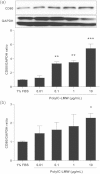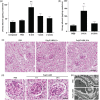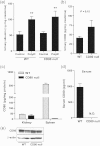Toll-like receptor 3 ligand, polyIC, induces proteinuria and glomerular CD80, and increases urinary CD80 in mice - PubMed (original) (raw)
Toll-like receptor 3 ligand, polyIC, induces proteinuria and glomerular CD80, and increases urinary CD80 in mice
Takuji Ishimoto et al. Nephrol Dial Transplant. 2013 Jun.
Abstract
Background: We have reported that children with biopsy-proven minimal change disease (MCD) express CD80 (also known as B7.1) in their podocytes and excrete high levels of CD80 in their urine during active nephrotic syndrome. We also reported that polyIC, a Toll-like receptor 3 ligand, increases CD80 mRNA and protein expression in cultured human podocytes dose-dependently, with actin re-organization and a reduction in synaptopodin expression.
Methods: To determine the effect of polyIC in the kidney, we subjected mice to systemic injection of polyIC or phosphate buffered saline.
Results: Mice injected with polyIC developed significant proteinuria with increased urinary CD80 excretion. Glomeruli from mice injected with polyIC were normal by light microscopic examination, but showed increased CD80 production in podocytes by immunofluorescence staining. In isolated glomeruli from mice injected with polyIC, expressions of CD80 and interleukin 10 significantly increased with a mild non-significant increase in CTLA-4, and synaptopodin expression decreased significantly.
Conclusions: Our study demonstrates that systemically administered polyIC can induce transient proteinuria and urinary CD80 excretion with an increase in CD80 production in podocytes, increased glomerular CD80 and reduced synaptopodin expression. These findings may be relevant to the pathogenesis of proteinuria in MCD.
Keywords: CD80; animal models; minimal change disease; nephrotic syndrome; proteinuria.
Figures
FIGURE 1:
PolyIC-LMW increases CD80 on cultured human podocytes. Cultured human podocytes were stimulated with various concentrations of polyIC-LMW. FBS 1% was used as a control. (a) Total protein was extracted from the cells and processed for western blotting for human CD80. The results represent the means ± SEM (_n_= 3 wells) **P < 0.01; ***P < 0.001 versus 1% FBS. (b) Total RNA was extracted from the cells and processed for real-time PCR for human CD80. The results represent the means ± SEM (_n_= 3 wells). *P < 0.05 versus 1% FBS. GAPDH was used as an internal control.
FIGURE 2:
Intravenous injection of polyIC-LMW induces transient albuminuria in mice. Mice were intravenously injected with polyIC-LMW or PBS. (a) Twenty-four-hour urine was collected at 24 h (0–24 h), 1 week and 2 weeks. Urinary albumin-to-creatinine ratio was measured. The results represent the means ± SEM (n = 5). **P < 0.01 versus uninjected, PBS and 2 weeks. (b) Six-hour urine (0–6 h) or 18-h (6–24 h) urine were collected at 6 or 24 h, respectively. Urinary albumin-to-creatinine ratio was measured. The results represent the means ± SEM (n = 5). *P < 0.05 versus PBS and 6–24 h. (c and d) Histological sections of the kidneys (at 6 and 24 h) of mice injected with polyIC-LMW or PBS were stained with PAS. Bar, 50 μm in (c) and 20 μm in (d). (e) Electron microscopy of the kidneys of mice injected with polyIC-LMW or PBS. Bar, 1 μm.
FIGURE 3:
PolyIC-LMW induces urinary CD80 excretion and CD80 production in kidneys. Mice were intravenously injected with polyIC-LMW or PBS. (a) Twenty-four-hour urine was collected at 24 h and 1 week. Urinary concentration of CD80 protein was determined by ELISA, and was corrected by creatinine concentration. The results represent means ± SEM (n = 5). *P < 0.05 versus PBS and 1 week. (b) The kidney samples at 6 and 24 h after the injection were homogenized and then centrifuged. The amount of CD80 in each supernatant was measured by ELISA. The results represent means ± SEM (n = 5). *P < 0.001 versus uninjected, PBS and 1 week. (c) Total RNA was extracted from the kidney samples at 6 and 24 h after the injection. The expression of CD80 was assessed by real-time PCR. The results represent the means ± SEM (n = 5). *P < 0.001 versus uninjected and PBS. #P < 0.01 versus 6 h. β-actin was used as an internal control.
FIGURE 4:
The expressions of TLRs in murine glomeruli. Isolated murine glomeruli from mice injected with PBS were subjected to real-time PCR for murine TLRs. The results represent the means ± SEM (n = 3). β-actin was used as an internal control.
FIGURE 5:
The effect of polyIC-LMW in glomeruli. Mice were intravenously injected with polyIC-LMW or PBS. Glomeruli were isolated at 6 h, and then subjected to real-time PCR for CD80 (a), TLR3 (b), synaptopodine (c), CTLA-4 (d), IL-10 (e) and angiopoietin-like 4 (f). The results represent means ± SEM (n = 5). **P < 0.01, *P < 0.05 versus PBS. N.S., not significant. β-actin was used as an internal control.
FIGURE 6:
The examinations using CD80 null mice. (a and b) WT mice and CD80 null mice were intravenously injected with polyIC-LMW. (a) Twenty-four-hour urine was collected at 24 h (0–24 h). Control urine was collected 1 week prior to the injection of polyIC-LMW. Urinary albumin-to-creatinine ratio was measured. The results represent means ± SEM (n = 6). **P < 0.01 versus respective control. (b) Urinary concentration of CD80 protein was determined by ELISA, and was corrected by creatinine concentration. The results represent the means ± SEM (n = 5). (c) CD80 contents in the kidney and spleen of WT mice and CD80 null mice measured by ELISA. The results represent means ± SD (n = 3). (d) Serum CD80 concentration measured by ELISA. The results represent the means ± SD (n = 3). (e) Representative images of western blotting for CD80 using the kidney of WT mice and CD80 null mice.
Similar articles
- Toll-like receptor 3 ligands induce CD80 expression in human podocytes via an NF-κB-dependent pathway.
Shimada M, Ishimoto T, Lee PY, Lanaspa MA, Rivard CJ, Roncal-Jimenez CA, Wymer DT, Yamabe H, Mathieson PW, Saleem MA, Garin EH, Johnson RJ. Shimada M, et al. Nephrol Dial Transplant. 2012 Jan;27(1):81-9. doi: 10.1093/ndt/gfr271. Epub 2011 May 26. Nephrol Dial Transplant. 2012. PMID: 21617192 - Upregulation of CD80 on glomerular podocytes plays an important role in development of proteinuria following pig-to-baboon xeno-renal transplantation - an experimental study.
Rivard CJ, Tanabe T, Lanaspa MA, Watanabe H, Nomura S, Andres-Hernando A, Garth K, Sekijima M, Ishimoto T, Ariyoshi Y, Garcia GE, Shah J, Lennan B, Tasaki M, Pomposelli T, Shimizu A, Sachs DH, Johnson RJ, Yamada K. Rivard CJ, et al. Transpl Int. 2018 Oct;31(10):1164-1177. doi: 10.1111/tri.13273. Epub 2018 Jun 5. Transpl Int. 2018. PMID: 29722117 Free PMC article. - Glomerular endothelial cells and podocytes can express CD80 in patients with minimal change disease during relapse.
Cara-Fuentes G, Venkatareddy M, Verma R, Segarra A, Cleuren AC, Martínez-Ramos A, Johnson RJ, Garg P. Cara-Fuentes G, et al. Pediatr Nephrol. 2020 Oct;35(10):1887-1896. doi: 10.1007/s00467-020-04541-3. Epub 2020 May 12. Pediatr Nephrol. 2020. PMID: 32399663 Free PMC article. - Minimal change disease: a CD80 podocytopathy?
Ishimoto T, Shimada M, Araya CE, Huskey J, Garin EH, Johnson RJ. Ishimoto T, et al. Semin Nephrol. 2011 Jul;31(4):320-5. doi: 10.1016/j.semnephrol.2011.06.002. Semin Nephrol. 2011. PMID: 21839364 Review. - The role of B7-1 in proteinuria of glomerular origin.
Novelli R, Benigni A, Remuzzi G. Novelli R, et al. Nat Rev Nephrol. 2018 Sep;14(9):589-596. doi: 10.1038/s41581-018-0037-z. Nat Rev Nephrol. 2018. PMID: 29959373 Review.
Cited by
- Toll-like Receptors in the Vascular System: Sensing the Dangers Within.
Goulopoulou S, McCarthy CG, Webb RC. Goulopoulou S, et al. Pharmacol Rev. 2016 Jan;68(1):142-67. doi: 10.1124/pr.114.010090. Pharmacol Rev. 2016. PMID: 26721702 Free PMC article. Review. - The role of the immune system in idiopathic nephrotic syndrome.
Hackl A, Zed SEDA, Diefenhardt P, Binz-Lotter J, Ehren R, Weber LT. Hackl A, et al. Mol Cell Pediatr. 2021 Nov 18;8(1):18. doi: 10.1186/s40348-021-00128-6. Mol Cell Pediatr. 2021. PMID: 34792685 Free PMC article. Review. - CTLA4-Ig in B7-1-positive diabetic and non-diabetic kidney disease.
Bassi R, Fornoni A, Doria A, Fiorina P. Bassi R, et al. Diabetologia. 2016 Jan;59(1):21-29. doi: 10.1007/s00125-015-3766-6. Epub 2015 Sep 26. Diabetologia. 2016. PMID: 26409459 Free PMC article. Review. - PolyIC Induces Retinoic Acid-inducible Gene-I and Melanoma Differentiation-associated Gene 5 and Modulates Inflammation in Podocytes.
Nakata M, Shimada M, Narita-Kinjo I, Nagawa D, Kitayama K, Hamadate M, Miura N, Nozaka M, Kawamura Y, Fujita T, Murakami R, Imaizumi T, Nakamura N, Tomita H. Nakata M, et al. In Vivo. 2021 Jan-Feb;35(1):147-153. doi: 10.21873/invivo.12242. In Vivo. 2021. PMID: 33402460 Free PMC article. - TLR-mediated albuminuria needs TNFα-mediated cooperativity between TLRs present in hematopoietic tissues and CD80 present on non-hematopoietic tissues in mice.
Jain N, Khullar B, Oswal N, Banoth B, Joshi P, Ravindran B, Panda S, Basak S, George A, Rath S, Bal V, Sopory S. Jain N, et al. Dis Model Mech. 2016 Jun 1;9(6):707-17. doi: 10.1242/dmm.023440. Epub 2016 Apr 28. Dis Model Mech. 2016. PMID: 27125280 Free PMC article.
References
- Abbas AK, Sharpe AH. T-cell stimulation: an abundance of B7s. Nat Med. 1999;5:1345–1346. - PubMed
- Garin EH, Mu W, Arthur JM, et al. Urinary CD80 is elevated in minimal change disease but not in focal segmental glomerulosclerosis. Kidney Int. 2010;78:296–302. - PubMed
Publication types
MeSH terms
Substances
LinkOut - more resources
Full Text Sources
Other Literature Sources





